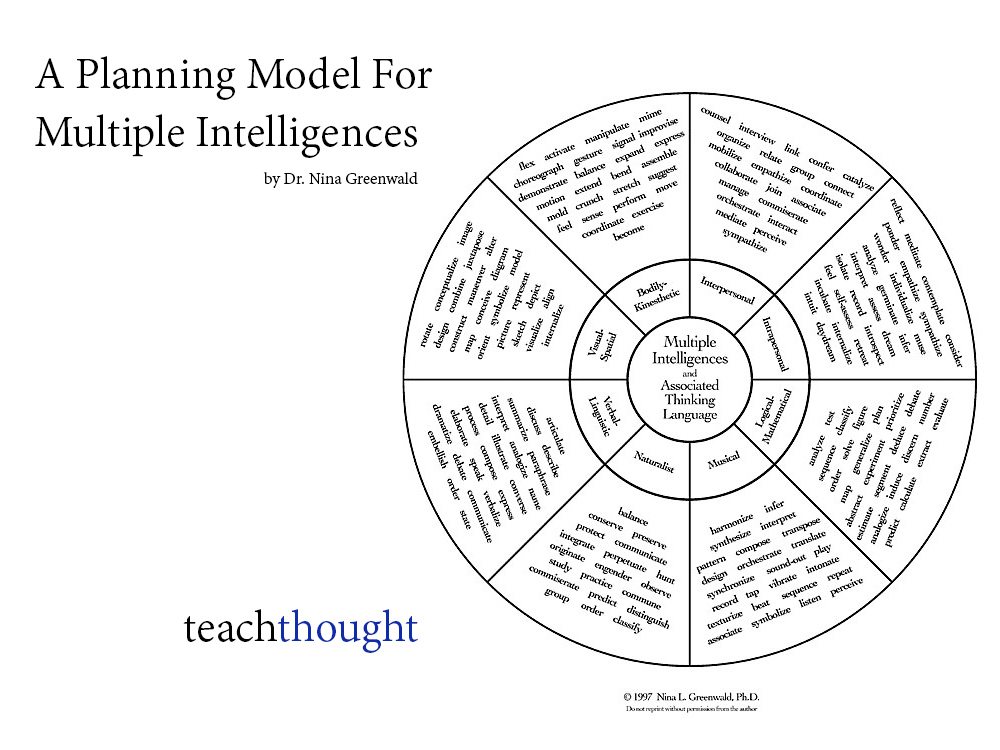
A Teacher Planning Model For Multiple Intelligences
by TeachThought Staff
Until recently, the prevailing thought in education was that differentiation according the theory of multiple intelligences was a good thing.
Then data started coming out, and the theories Howard Gardner set forth back in 1983 came under fire. Mention multiple intelligence (MI) thinking today, and you’re guaranteed to rise the ire of someone on twitter telling you that it’s 2021 and the 1980s are gone and there is no data that exists that proves MI does anything but waste time.
The Background
Gardner’s theory was more about rethinking intelligence than suggesting we teach algebra by jump roping. He suggested 8 sects of intelligence replace our singular idea of general intelligence. (He has since suggested a 9th intelligence–Existential).
8 Multiple Intelligences According To Howard Gardner
According to the John Hopkins School of Education, each intelligence can be defined as follows:
- “Visual/Spatial – Involves visual perception of the environment, the ability to create and manipulate mental images, and the orientation of the body in space.
- Verbal/Linguistic – Involves reading, writing, speaking, and conversing in one’s own or foreign languages.
- Logical/Mathematical – Involves number and computing skills, recognizing patterns and relationships, timeliness and order, and the ability to solve different kinds of problems through logic.
- Bodily/Kinesthetic – Involves physical coordination and dexterity, using fine and gross motor skills, and expressing oneself or learning through physical activities.
- Musical – Involves understanding and expressing oneself through music and rhythmic movements or dance, or composing, playing, or conducting music.
- Interpersonal – Involves understanding how to communicate with and understand other people and how to work collaboratively.
- Intrapersonal – Involves understanding one’s inner world of emotions and thoughts, and growing in the ability to control them and work with them consciously.
- Naturalist – Involves understanding the natural world of plants and animals, noticing their characteristics, and categorizing them; it generally involves keen observation and the ability to classify other things as well.”
These theoretical multiple intelligences gave rise to the idea of learning styles that serve each of those intelligences. Because the brain works this way, we might consider designing learning experiences that way. Unfortunately, for some this sounds a lot like research-based excuse-making, where a ‘Kinesthetic’ learner ‘can’t learn’ by listening or reading.
See also Stop Saying Learning Styles Don’t Work
In spite of this misunderstanding, and of the unconvincing body of research supporting ‘multiple intelligences,’ using the framework to plan can be useful because they represent ways of thinking, acquiring data, connecting to content, and providing a foundation for learning experience. It may well be that letting one child learn one through intrapersonal reflection and another through interpersonal connections may not provide an advantage to either child.
That, however, does nothing to dissolve the utility of thinking of multiple intelligences as a way to design learning experiences.
As a teacher, how can I promote spatial thought? How can I encourage every student to be ‘linguistic’ in a way that’s authentic to them? How can I use one student’s tendency to ‘move’ to support them in developing other less-developed areas?
In that context, the above framework from Dr. Nina Greenwald is useful, primarily due to its inclusion of relevant language for each intelligence. It parallels other Bloom’s Taxonomy posters, but refracted through thinking about unique intelligences.
Swoon!
Image adapted and used with written permission from Dr. Greenwald; Greenwald, Nina L. “Songs the Dinosaurs Sang” Gifted Child Today, November/December, 1998, Volume 21, No. 6; A Teacher Planning Model For Multiple Intelligences
